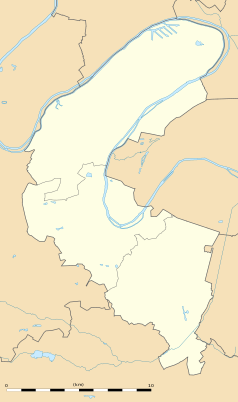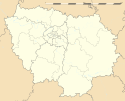Boulogne-Billancourt
| miejscowość i gmina | |||
 | |||
| |||
| Państwo | |||
|---|---|---|---|
| Region | |||
| Departament | |||
| Okręg | |||
| Kod INSEE | 92012 | ||
| Mer | |||
| Powierzchnia | 6,17 km² | ||
| Populacja (2012) • liczba ludności |
| ||
| • gęstość | 19 307 os./km² | ||
| Kod pocztowy | 92100 | ||
Położenie na mapie Hauts-de-Seine (c) Eric Gaba, Wikimedia Commons user Sting, CC BY-SA 3.0 | |||
Położenie na mapie Île-de-France (c) Eric Gaba, Wikimedia Commons user Sting, CC BY-SA 3.0 | |||
| Portal | |||
Boulogne-Billancourt – miejscowość i gmina we Francji, w regionie Île-de-France, w departamencie Hauts-de-Seine. Przez miejscowość przepływa Sekwana[3].
Według danych na rok 2015 gminę zamieszkiwały 119 127 osób[2], a gęstość zaludnienia wynosiła 19 307 osób/km². Wśród 1287 gmin regionu Île-de-France Boulogne-Billancourt plasuje się na 2. miejscu pod względem liczby ludności, natomiast pod względem powierzchni na miejscu 601.).
W Boulogne-Billancourt zmarł i został pochowany hiszpański malarz kubistyczny Juan Gris.
Położenie
Boulogne-Billancourt położone jest nad Sekwaną i graniczy od wschodu z 16. dzielnicą Paryża i od północy z wchodzącym w jej skład Laskiem Bulońskim. Przez Sekwanę graniczy z Saint-Cloud, Sèvres, Meudon oraz Issy-les-Moulineaux.
Historia
Od X w. na terenie późniejszego miasta istniała wioska Menuls-lès-Saint-Cloud. Nazwa Boulogne zaczęła być używana wraz z ukończeniem w 1330 gotyckiego kościoła pod wezwaniem Notre-Dame de Boulogne (N.M.P. z Boulogne). Przez długi czas Boulogne pozostawało miasteczkiem rolniczym. W XVIII i XIX w. zaczęły powstawać bogate rezydencje. Równolegle rozwijała się manufaktura i później przemysł. W XVII w. pojawiły się farbiarnie i pralnie. Pod koniec XIX w. w Boulogne rozwijał się przemysł lotniczy (Voisin, Kapferer, Farman), samochodowy (Renault skonstruował tam swoje pierwsze auto w 1898), filmowy (Abel Gance, Jean Renoir). W 1925 Boulogne zostało połączone z miejscowością Billancourt i oficjalnie zmieniło nazwę na Boulogne-Billancourt. W latach 30. XX wieku Boulogne-Billancourt stało się swoistym laboratorium architektury francuskiej, przede wszystkim modernistycznej, w której dominowała funkcjonalność i racjonalność.
Gospodarka
Boulogne-Billancourt jest główną siedzibą koncernu motoryzacyjnego Renault oraz Française des Jeux, przedsiębiorstwa publicznego posiadającego we Francji monopol na organizację loterii i zakłady sportowe. W mieście swoją siedzibę na Francję ma też niemiecki koncern Henkel KGaA[4] oraz katarska telewizja sportowa BeIN Sport.
Edukacja
- École supérieure des sciences commerciales d'Angers
Kultura i sztuka
Muzea
W Boulogne-Billancourt istnieje kilka muzeów:
- Atelier Joseph-Bernard
- Biblioteka-Muzeum Marmottan
- Centrum Interpretacyjne Architektury i Dziedzictwa
- Espace Landowski
- Muzeum-Ogród Paul-Landowski
- Muzeum departamentalne Albert-Kahn
- Muzeum lat 30.
Kina
Kina funkcjonujące w Boulogne-Billancourt:
- Pathé Boulogne
- Cinéma Landowski
Parki i ogrody miejskie
- Parc Edmond de Rothschild
- Parchamp
- Parc des Glacières
- Square des Dominicaines
- Mail du maréchal Juin
- Jardins de la résidence Pouillon
- Square Farman
- Square de la rue des Longs Près
- Square de la rue Thiers
- Jardins de l'Hôtel de ville
- Parc de Billancourt
- Parc de l'île Seguin
Miasta partnerskie
 Belgia: Anderlecht
Belgia: Anderlecht Niemcy: Neukölln
Niemcy: Neukölln Wielka Brytania: Hammersmith and Fulham
Wielka Brytania: Hammersmith and Fulham Holandia: Zaanstad
Holandia: Zaanstad Włochy: Marino
Włochy: Marino Serbia: Pančevo
Serbia: Pančevo Izrael: Ra’ananna
Izrael: Ra’ananna Stany Zjednoczone: Irving
Stany Zjednoczone: Irving Tunezja: Susa, Tunezja
Tunezja: Susa, Tunezja Wybrzeże Kości Słoniowej: Abidżan
Wybrzeże Kości Słoniowej: Abidżan
Zobacz też
- Parafia św. Mikołaja w Boulogne-Billancourt
Przypisy
- ↑ od 16 marca 2008 r.
- ↑ a b INSEE: Recensement de la population 2015. [dostęp 2018-06-10]. (fr.).
- ↑ Fiche cours d'eau / La Seine (----0010). SANDRE. [dostęp 2016-04-25]. (fr.).
- ↑ Henkel supprime deux usines en France, „Le Figaro”, 24 listopada 2008.
Bibliografia
- Francuski urząd statystyczny. (fr.).
Linki zewnętrzne
Media użyte na tej stronie
Autor: Superbenjamin, Licencja: CC BY-SA 4.0
Blank administrative map of France for geo-location purpose, with regions and departements distinguished. Approximate scale : 1:3,000,000
(c) Eric Gaba, Wikimedia Commons user Sting, CC BY-SA 3.0
Blank administrative map of the region of Île-de-France, France, as in January 2015, for geo-location purpose, with distinct boundaries for regions, departments and arrondissements.
Flag of Israel. Shows a Magen David (“Shield of David”) between two stripes. The Shield of David is a traditional Jewish symbol. The stripes symbolize a Jewish prayer shawl (tallit).
The flag of Navassa Island is simply the United States flag. It does not have a "local" flag or "unofficial" flag; it is an uninhabited island. The version with a profile view was based on Flags of the World and as a fictional design has no status warranting a place on any Wiki. It was made up by a random person with no connection to the island, it has never flown on the island, and it has never received any sort of recognition or validation by any authority. The person quoted on that page has no authority to bestow a flag, "unofficial" or otherwise, on the island.
Flag of the Ivory Coast, written by Jon Harald Søby, modified by Zscout370. The colors match to what is reported at http://fotw.vexillum.com/flags/ci.html.
Autor: Bledard92, Licencja: CC BY-SA 3.0
Église Notre-Dame de Boulogne à Boulogne-Billancourt
Autor: Patricia.fidi, Licencja: CC0
Unofficial (de facto) flag of the region Île-de-France in France. It was also the flag of the kingdom of France (s.XIV-XV)
(c) Eric Gaba, Wikimedia Commons user Sting, CC BY-SA 3.0
Blank administrative map of the department of the Hauts-de-Seine, France, as in January 2015, for geo-location purpose, with distinct boundaries for departments and arrondissements.
Map of Paris and its inner ring départements, localization of Boulogne-Billancourt (Author: Metropolitan).
























